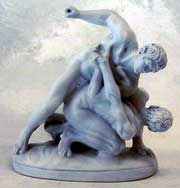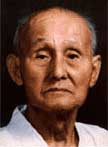 |
A Short History of Wado-Ryu
Karate
|

|
The Origins of Karate can be traced back as far as the
Greek Olympic games of 776 B.C. An event called the Pankration,
which was a mixture of wrestling and boxing, usually resulted
in the winner being alive at the end of the match.
Alexander the Great's conquest of India had led to this
type of contest influencing Buddhist Missionaries who saw
the potential of unarmed combat as a way of protecting themselves
on their travels without the use of forbidden weapons.
|
|
As Buddhism spread into China, other sects grasped the
essence of the 'Empty Hand' and modified it according to
creed and temperament.
Karate spread through China, across the Ryu Kyu Islands
and finally to the chain's main land-mass, Okinawa.
|

|
Wado-Ryu's origins can actually be traced to a Chinese Monk, Chin
Genpin, who is reputed to have introduced Kempo (Fist Art) into
Japan in the 17th Century.
Later, the Shindo Yoshin-Ryu system set the basis for the Wado-Ryu
style. It is unique amongst the other Ju-Jitsu systems as it stresses
the art of Atemi or striking the vital and vulnerable parts of
the body rather than the traditional Jitsu of throwing or locking
the limbs. The originator of this style. Master Yoshitoki Akiyama,
developed the underlying principal after visiting China to study
medicine. Whilst he was there he started training in a form of
Atemi. On his return to Japan he continued his practice of Atemi
but feeling a spiritual emptiness embarked upon a period of intense
meditation in his search of enlightenment. At the end of a period
of 100 days of rigorous meditation he happened to gaze upon a
willow tree. It was snowing at this time and Akiyama was struck
by how the branches of the tree would bend as the weight of the
snow built up on them and how the snow would slide off once the
bough was loaded with enough weight. Had the tree not yielded
to the weight of the snow the branches would surely have snapped.
This seemingly mundane observation enthused Akiyama and he used
it as the basis for a new theory of Karate.
|
There were other senseis who developed the theory as time
went on until Master Hinori Ohtsuka
formalised the Wado-Ryu techniques: but the underlying ethos
remained the same - a basic philosophy of non-confrontation
either physically or mentally.
|

|
Karate did not come to mainland Japan until 1921 when the Okinawan
Master. Ginchin Funakoshi, travelled there.
Hinori Ohtsuka - the founder of Wado-Ryu
- was an accomplished Ju-Jitsu expert who had received his license
to teach from Tatsusaburo Nakayama (the then head of the Shindo
Yoshin-Ryu style). Hinori Ohtsuka made the pilgimage to train
with Master Funakoshi in the new area of Tode (Karate) which Funakoshi
had brought from Okinawa. Ohtsuka was so adept and quick to learn
that Funakoshi could not believe that Ohtsuka had not trained
in Karate before. He so impressed Master Funakoshi that he seconded
him in many demonstrations in Japan to promote the new art.
It was in 1935 that Budo - Japan's National Governing Body for
the martial arts - recognised the style of Wado-Ryu and the Way
of Peace style was born.
|
 |












